Contents
The formation of a grape bush has always been considered a difficult task. Indeed, depending on the region, variety and time of year and age, the plants must be cut according to certain rules. Pruning grapes in the fall is one of the main agricultural practices. The article informs you when to prune grapes in autumn and how to do it correctly so that the vineyards will delight you with a plentiful rich harvest.
Properly pruning grapes, first of all, is necessary to increase the volume of the harvest. In addition, after cutting, the size of the berries increases and their taste becomes richer due to a greater influx of beneficial nutrients. An uncircumcised bush will spend all its strength on growth – it will have a long vine, but small clusters with unsweetened berries.
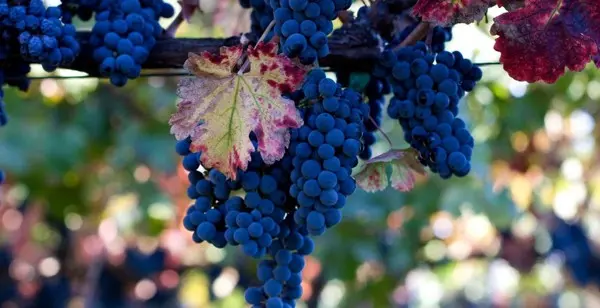
In the middle lane, where sheltered viticulture is practiced, grape pruning is traditionally carried out in the fall, primarily because such care protects the vineyards from frost. Also, on a branch shortened during this period, more berries appear.
In the middle lane, where sheltered viticulture is practiced, grapes are traditionally pruned in autumn.
Spring pruning is not recommended. The vine heals wounds with difficulty and for a long time, and if some of the branches are cut off at the beginning of the sap flow period, such wounds will begin to “cry”, which can lead to the death of the entire plant. In March, when the constant air temperature no longer drops below +5 degrees Celsius, you can carefully prune young grapes that have not yet fruited, or prune seedlings planted in autumn.
In summer, they do not touch the grape bushes, but only carry out preventive measures aimed at increasing the influx of nutrients and ripening the clusters: pinching, breaking out the branches, chasing, pinching, thinning the leaves.
Autumn pruning should be done at the end of the season, but at positive temperatures. Night frosts, even down to -12 degrees Celsius, are not terrible for the vine. By letting the grapes hang longer, we help to ensure that more nutrients move to the roots of the plant, and these reserves are necessary for growth and successful fruiting next year. But it’s not worth delaying circumcision either – you need to be guided by the weather.
Trimming instruction
There are a considerable number of options for the formation of a grape bush, but they are all divided into two main types: covering and non-covering. Covering events are held in regions with frosty winters, where it is customary to cover the vine under the snow, these include fan and cordon schemes. Non-covering ones are used in areas of traditional viticulture (Crimea, southern regions). These include standard and gazebo schemes. Also, such pruning is carried out in the middle lane, but only for frost-resistant varieties.
Fan
The fanless stemless scheme is used in the northern regions with a covering type of viticulture. Such pruning forms several sleeves, the number of which can be adjusted, growing vertically from the base of the bush, but located at different angles and forming a fan. Such branches can be easily moved in order to shelter from winter frosts. The fan scheme contributes to the rapid rejuvenation of the plant without reducing the yield.
The fan scheme contributes to the rapid rejuvenation of the plant without reducing the yield.
With fan-shaped formation, the task is to grow several sleeves, which will be the basis for a fruit-bearing vine. We begin to form a scheme already in the first year of the seedling’s growth, cutting it off in the fall by 2-3 buds (it is possible for two, but the third goes as a spare in case of freezing). If in the spring all three eyes went into growth, then we pinch one sprout, leaving two young ones on different sides of the main shoot. By autumn, a two-year-old seedling produces two already fairly strong shoots, which must be cut into a replacement knot, leaving 3-4 eyes.
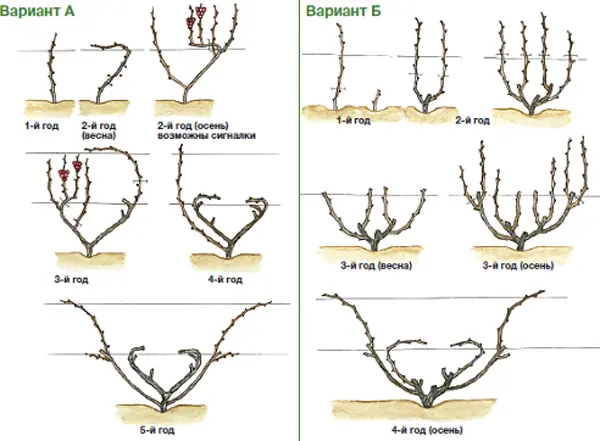
Fan pruning patterns
In the third year, the seedling begins to form sleeves. In the spring, when the buds begin to grow, we leave 2 young shoots on each of the two strong shoots. Moreover, it is necessary to make sure that the lower sprout looks outward of the shoot. With the onset of autumn, these sprouts are already quite strong – they grow up to 1 meter in length and 6-10 mm in diameter. Future sleeves are cut off, leaving at least 50 cm branches and tied to a stretched wire at a height of 30 cm from the ground. It is necessary to cut it correctly so that the inner sleeves of the resulting fan are shorter than the outer ones.
On the sleeves formed in this way, during the growing season, all annual sprouts are broken out, except for the top 2-3, which form a fruitful vine, which must be tied vertically to the trellis. At this stage, the formation of the fan ends.
Further, on each of the sleeves in the autumn of next year, it is necessary to properly cut the shoots: the upper one is usually cut into 7-8 buds (fruitful), and the lower one – by 2-3 buds (replacement knot), thus forming a fruit link. After trimming, the fan will consist of four sleeves and four fruit links.
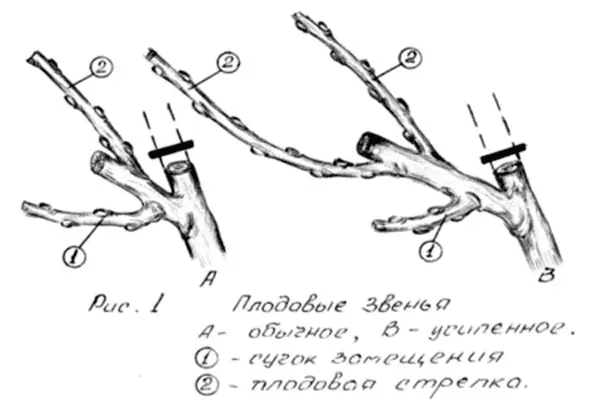
Then, every autumn, the fruiting vine should be cut off and a new fruit link should be formed from young shoots that have grown from the replacement knot.
The fan pattern contributes to the slow growth of the sleeves. For their rejuvenation, it is better to cut off the old one to a restoration knot, leaving 2-3 buds at the base of the plant.
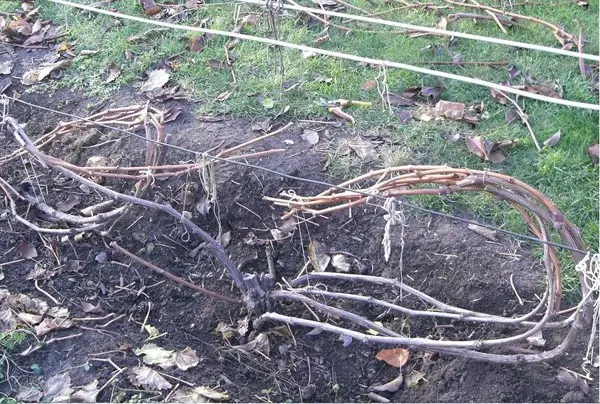
Video “Pruning grapes in autumn”
This video will show you how to fan trim.
Standard
This scheme is used by winegrowers when pruning uncovered grape varieties mainly in the southern regions and the Crimea.
The first autumn pruning of a young seedling leaves 2-3 eyes above the ground. Next, the strongest is selected from the two sprouts, from which they will form a bole (trunk), the second is also saved as a reserve. In autumn, the main sprout is shortened by 2-3 buds, and the reserve is cut into a replacement knot, keeping 2 buds. At this stage, all other young sprouts break out. In the second year, the stem growth point is pinched (letting it ripen), while all stepchildren are also removed. In the third year, the trunk must be cut to the desired height, while removing all the processes, but retaining the top two – they are cut off, leaving 2 buds on each. These branches will be the shoulders of the cordon. At their level, they stretch the wire and tie future sleeves to it. The reserve shoot is also shortened, keeping the two strongest shoots, one of which leaves 2 buds (replacement knot), and the second – 4-6 buds.
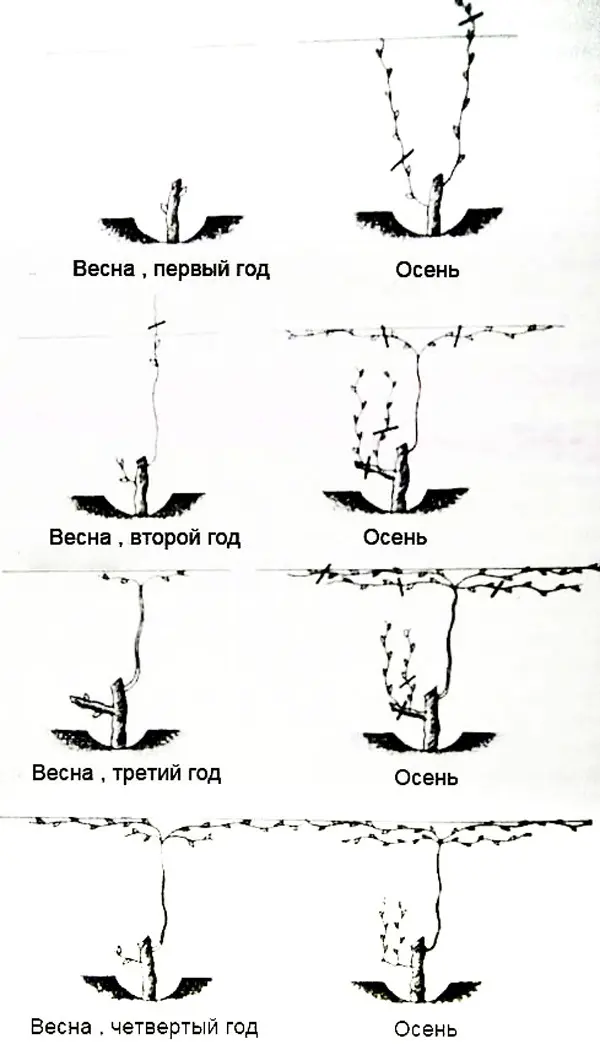
In the fourth year of formation, according to the characteristics of the variety, the shoulders are shortened, the extra shoots break off so that there is a distance of about 20 cm between the remaining ones: the so-called “horns” are laid, which will be the bases of the fruit links.
In the fifth year, 2-3 eyes are kept on each grown shoot, the rest is cut off. In September of the sixth year, on the grown annual shoots, we correctly form fruit links, cutting off the upper shoot by 6-7 buds (fruit vine), and the lower one by a replacement knot (2-3 buds). At this stage, the formation of the standard scheme ends. In subsequent years, the formation is only maintained: every autumn a fruitful vine is cut off, and a new fruit link is formed from the shoots of the replacement knot.
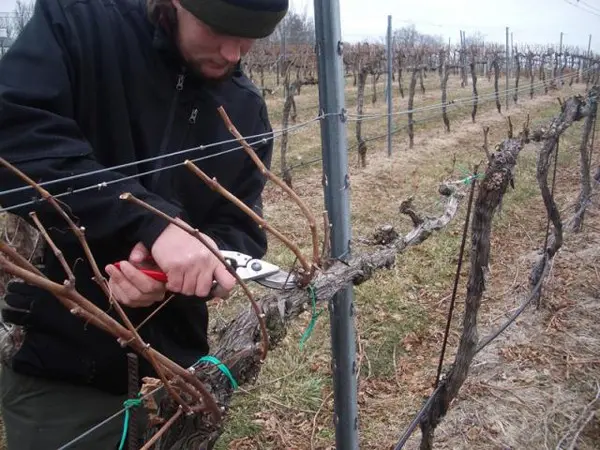
Features of age pruning
The life cycle of each grape bush can be divided into three stages:
- increase in vegetative mass;
- fruiting;
- extinction of life cycles.
Pruning during each of these cycles has its own specific goals and has some specific features.
young bushes
Young grape bushes up to 5-6 years old accumulate vegetative mass and prepare for fruiting, so the main goal of pruning at this time is the correct approach to the formation of the bush, its skeleton and shape, so that it begins to bear fruit faster and more abundantly.
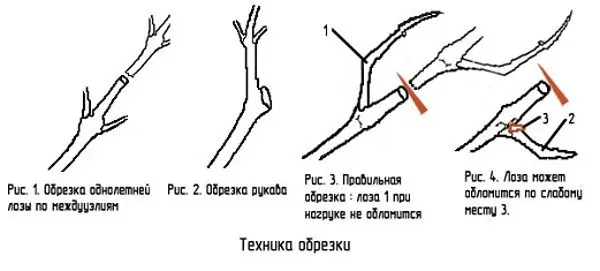
Vine pruning scheme
Pruning begins from the first year of a seedling’s life and comes down to the annual cutting off of excess shoots, forming the main sleeves, which will be the basis of the fruit links.
The basic rule in the formation of a young vineyard, which all beginners should learn, is that the vine should not “fatten”.
The basic rule in the formation of a young vineyard, which all beginners should learn, is that the vine should not “fatten”. Such a vine drops inflorescences, respectively, gives less yield, while the quality of the berries also deteriorates.
adult bushes
Pruning grapes during the fruiting period, which can last for 20-25 years, is primarily aimed at preserving the pattern of bush formation, its fruiting and growth regulation. At this time, the plant can get sick, so pruning helps to get rid of dry, dead, diseased shoots, replacing them with young ones.
The main purpose of pruning a neglected old bush is to form fruit links on the shoulders or sleeves, which are the basis of high yields. During pruning, up to 70-90% of the vine can be removed.
Pruning grapes in autumn promotes high yields. By applying the optimal pruning scheme suitable for the climate of your region, you can not only increase the fruiting of grapes, protecting them from frost and sudden changes in temperature, but also improve the taste of berries that will decorate your table.









